skip to main |
skip to sidebar
My city has had 35 Mayors since the April 1889 Land Run (* are provisional/temporary mayors before the city's incorporation): | Mayor | From | Until | | 1 | * William L. Couch | April 27, 1889 | November 11, 1889 | | 2 | * Andrew Jackson Beale | November 27, 1889 | December 30, 1889 | | 3 | * D.W. Gibbs | July 15, 1890 | August 9, 1890 | | 4 | W.J. Gault | August 12, 1890 | April 12, 1892 | | 5 | O.A. Mitscher | April 23, 1892 | April 9, 1894 | | 6 | Nelson Button | April 9, 1894 | April 13, 1896 | | 7 | Charles Graham Jones | April 13, 1896 | April 12, 1897 | | 8 | J.P. Allen | April 12, 1897 | April 10, 1899 | | 9 | Lee Van Winkle | April 10, 1899 | April 8, 1901 | | 10 | Charles Graham Jones | April 8, 1901 | April 13, 1903 | | 11 | Lee Van Winkle | April 13, 1903 | April 10, 1905 | | 12 | J.G. Messenbaugh | April 10, 1905 | April 8, 1907 | | 13 | Henry M. Scales | April 8, 1907 | April 11, 1910 | | 14 | Dan V. Lackey | April 11, 1910 | June 8, 1911 | | 15 | Whit M. Grant | June 8, 1911 | April 13, 1915 | | 16 | Edward Overholser | April 13, 1915 | December 24, 1918 | | 17 | Byron D. Shear | December 25, 1918 | April 7, 1919 | | 18 | John Calloway Walton | April 7, 1919 | January 9, 1923 | | 19 | Mike Donnelly | January 9, 1923 | April 4, 1923 | | 20 | O.A. Cargill | April 4, 1923 | April 12, 1927 | | 21 | Walter C. Dean | April 12, 1927 | April 12, 1931 | | 22 | C.J. Blinn | April 12, 1931 | November 7, 1933 | | 23 | Tom McGee | November 7, 1933 | April 9, 1935 | | 24 | John Frank Martin | April 9, 1935 | April 11, 1939 | | 25 | Robert A. Hefner | April 11, 1939 | April 8, 1947 | | 26 | Allen Street | April 8, 1947 | April 7, 1959 | | 27 | James H. Norick | April 7, 1959 | April 9, 1963 | | 28 | Jack S. Wilkes | April 9, 1963 | May 3, 1964 | | 29 | George H. Shirk | June 16, 1964 | April 11, 1967 | | 30 | James H. Norick | April 11, 1967 | April 13, 1971 | | 31 | Patience Latting | April 13, 1971 | April 12, 1983 | | 32 | Andy Coats | April 13, 1983 | April 14, 1987 | | 33 | Ron Norick | April 14, 1987 | April 9, 1998 | | 34 | Kirk Humphreys | April 9, 1999 | November 3, 2003 | | 35 | Mick Cornett | November 3, 2003 | Present |
Oklahoma City Mayors, Part 1, tells a little about our 1st mayor, William L. Couch, for whom Couch Drive is named.
WILLIAM L. COUCH
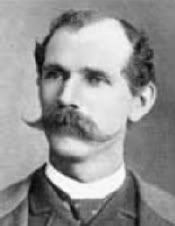 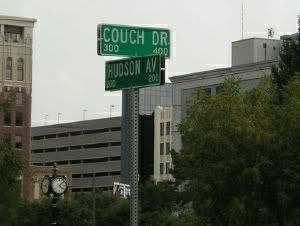 From http://geneasearch.com/biography/couch.htm: From http://geneasearch.com/biography/couch.htm:
William L. Couch was born in North Carolina in 1850. In 1866 his father's family moved to Johnson county, Kansas, and four years later, settled at the town of Douglas in Butler county.
In 1880 he became identified with the Payne-Oklahoma Colony and remained one of the most active leaders of that movement until, in November, 1884, he was chosen as Payne's successor.
He was the first mayor of Oklahoma City under the provisional government. He was shot during a dispute over a homestead claim at Oklahoma City, April 14, 1890, and died six days later. If you want to know more about Couch's leadership and involvement with the earlier "Boomer Movement" in Payne County, click here.
The United States Army was charged with keeping the peace and good order during the Land Run days, the military contingent being largely taken care of by Capt. D.F. Stiles, and Couch, the provisional and then temporary mayor of Oklahoma City, would need his help.
As for the initial election, A History of the State of Oklahoma (1908), Vol 1, pp. 219 and following describes it thusly:
CALL FOR MASS CONVENTION.
Oklahoma City, April 26, 1889.
We, citizens of the city of Oklahoma, request the meeting in mass convention of all citizens of the city for the purpose of nominating a temporary mayor and city recorder to hold their offices until such time as there may be elected by ballot their successors, which election shall be held within five days from and after the election of said mayor and recorder. Such mass meeting to be held April 27, 1889, at the hour of 6:30 o'clock p. m., and every citizen of said city shall be entitled to vote. The election of said temporary mayor and recorder shall be by the voice, and shall vest in them the power to appoint police to preserve the order of said city, and the power to call said election for permanent mayor, recorder and prescribe the manner of holding said election. Said mass meeting to be held at the corner of Main and Broadway.
(Signed) Ledru Guthrie, J. B. Weaver (not a citizen of the city, but living near the same), John B. Banks, S. Lum Biedler, W. P. Easton, J. E. Carson, J. D. Drake, T. B. Riley, G. A. Biedler, p. m., O. H. Violet, Sidney Clarke, Bluford Wilson, D. A. Harvey, W. P. Shaw.
[220]
"Boomer" Payne, was chosen for mayor, and William P. Shaw for provisional recorder. It is said that at the conclusion of the convention, all united in a grand chorus of "Praise God from Whom All Blessings Flow." That a host of settlers, suddenly gathered in one spot from all parts of the country, united in voicing the familiar doxology, whatever may have been the depth of feeling with which it was sung, is hardly less significant of the homogeneity of this typical American assemblage than the unanimity with which they adopted resolutions providing for a civil government.
Following the appointment, in convention, of temporary officials, Mayor Couch issued a proclamation for a regular election, set for May 1st. The corner of Main and Broadway was one polling place, and all who lived south of Clarke street (now Grand avenue) were to cast their ballots at the corner of California avenue and Broadway. "Captain Couch" (Confederate and so called in the Boomer Movement and so referenced in early writings) was elected temporary Mayor at the May 1, 1889, election.
His brief tenure as Oklahoma City's first mayor is nicely and contemporaneously described in several of the 1890 pages in the Letter of the Secretary of War to the US Congress.
From History of Oklahoma, Part 1, pages 219 and following,
The history of the provisional government of Oklahoma City embraces the principal events of the first year of the city's existence. The provisional government was the object of such active hostility on the part of the minority party, and involved so many question of fundamental importance in the career of the new country, that it was made the subject of an exhaustive inquiry by Congress, and the records of the time may be found largely in the reports made to Congress during its fifty-first session. A "Committee of Fifteen" was determined to call and have an election, apparently contrary to the legalities then involved. Mayor Couch enlisted the help of the military, Capt. D.F. Stiles, particularly. From page 223 of the same source,
Major Sanger in his report explains why the use of the military authority became necessary, in the character of the population that thronged over the site of Oklahoma City during the first day or so. "The crowd," he says, "was composed of people from all parts of the country, and embraced, among many honest settlers seeking homes, a class of dangerous lot-jumpers, land speculators, gamblers and sharpers, having no interest in the city or country beyond swindling the confiding and unwary, and pursuing their ordinary vocations as law-breakers. Of the truth of this there is ample evidence." The troops had entire charge of the city from April 22 to May 6, the United States marshals and the provisional civil authorities being unable to manage the great concourse of people without military aid.
It has been said that the de facto government of Oklahoma City, established soon after the opening, could not have existed without the support of the military. But this admission does not confirm the assertion, made by some in the early days of the city, that the troops were used to establish a quasi-martial law over the community, or that the influence of the civil authorities with the local commanding officers was unduly exercised to override the popular will. So far as the federal government interfered in local affairs, through its military arm, it was compelled to recognize the civil government established by regular and peaceable means. Furthermore, it appears that every time the troops were used to maintain order in the city, the local officers received instructions from their department commanders, and therefore could not be accused of discriminating in favor of one or the other faction.
Concerning the division of public sentiment in Oklahoma City during its first months, Major Sanger, who looked at conditions from the standpoint of the army, reported, in November, 1889, as follows:
"I have sought the views of many prominent citizens and am not without some information as to public sentiment on this point. Those who come within any of the classes referred to by me in these reports as gamblers, liquor dealers (or as they are called here, 'boot-leggers'), lot-jumpers and thieves, whose operations have been checked by the troops, do now, and will hereafter, unhesitatingly denounce them [the action of the troops and the established government]. They want no government, civil or military, which they cannot control, and are now to be found in the opposition. The body of reputable citizens is divided into two parties which do not follow the lines of the two great parties of the country, but along the lines of local interests. They are distinguished by [page 224] the names of two rival townsite companies organized before the opening of Oklahoma to locate townships and to secure town lots. They are the survivors of such companies on hand at the opening, and are known as Seminoles and Kickapoos; the latter in opposition to the civil and military government. As distinguished from the Kickapoos, I believe that every prominent business man in Oklahoma is either neutral or on the Seminole side. They have confidence in the military and desire to retain it here, with its sphere of duties undiminished. *** I'll not elaborate on this further here, but, if you're into detail, a more thorough read of the letters contained in the 1890 Secretary of War's report to the US Congress would probably catch your fancy.
Although Mayor Couch (barely) survived this period (as noted above, he was shot over a homestead claim at Oklahoma City, April 14, 1890, and died six days later), little could he know that the infant and raucous city he presided over during a few months in 1889 ...

would become this ...
Click the image for a larger pic
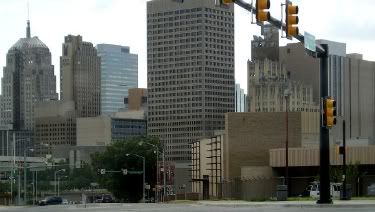
Here endeth the lesson, and our 1st mayor.
... Click here to read the full article and any comments ...
Edited & Updated 6/19/2007: The Oklahoma Heritage Association's Website has been majorly revised. Some quotes here are from the former website which do not exist in its current website.Also, see Oklahoma Hall of Fame. From 1909 and ninety years thereafter, the Mid-Continent Life Insurance Company was one of Oklahoma's most venerable life insurance companies. This postcard shows an artist's rendering of the building completed in 1927 at 1400 Classen Drive: 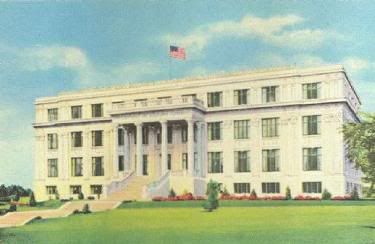
Credit Edwards and Ottaway, Vanished Splendor II (Abalache Book Shop Publishing Co. 1983) - click for larger pic
At the time Vanished Spendor II was published, Mid-Continent was still doing business at the above location. The building was then described,
The total floor space is 42,000 square feet. Local and regional suppliers were used for nearly all the materials needed for construction. The main entrance and doors and electrical fixtures are bronze, as is the hardware used throughout, including the specially cast bronze door knobs bearing the company's insignia. The exposed woodwork in the building is mahogany imported from British Honduras. The designer was Solomon Layton, who designed the State Capitol. It is constructed of Indiana limestone and carved Corinthian columns, and it's a beauty to behold.
But, apparently Mid-Continent's actuaries got something wrong because on April 14, 1997, an Oklahoma County District Judge simultaneously placed Mid-Continent in receivership and appointed the Oklahoma Insurance Commissioner as the Receiver. Eventually, another Oklahoma City company, American Fidelity Assurance Company, picked up the insurance policy pieces (see its website), but the building was abandoned.
ENTER THE OKLAHOMA HERITAGE ASSOCIATION

The property was purchased on September 5, 2001, by the Oklahoma Heritage Association for $3,000,000. From the former OHA website, it was said:
On September 5, 2001, the Oklahoma Heritage Association purchased the former Mid-Continent Life Insurance building at a cost of $3,000,000. The purchase was made possible through a donation by Edward L. Gaylord of Oklahoma City. Holdenville native T. Boone Pickens matched the $3 million contribution to launch the renovation of the historic structure so it could become the new home of the Oklahoma Heritage Association. “Right now we are in the middle of a $15 million capital campaign, and that contribution gave us the foundation on which to build,” says Shannon Nance, President of OHA. “We want to ensure that the diverse and rich history of our state’s people will be preserved and told to future generations of Oklahomans.” But, what IS the Oklahoma Heritage Association and where did it come from?
New revisions to OHA's website help a lot with that. See OHA's new history page.
One of OHA's functions is to determine inductees into the Oklahoma Hall of Fame. According to OHA's Hall of Fame page,
Being inducted into the Oklahoma Hall of Fame is the highest honor an Oklahoman can receive from the state. Since the Oklahoma Hall of Fame’s inception in 1927, 613 accomplished individuals have received this commendation. The names of the Hall of Fame members, as well as busts and portraits of these individuals, can be seen at the Gaylord-Pickens Oklahoma Heritage Center. In addition, the inductees are recognized on granite monuments in the Heritage Plaza at the Oklahoma State Fairgrounds. Awards "from the state?" No, not actually ... the awards are from a prestigious private organization that lives here, the Oklahoma Heritage Association. A "governmental" connection does not exist. That said, who wouldn't want to receive the organization's recognition and tap on the shoulder!
You can find a "list" of Hall of Fame inductees at OHA's website or in a related post in this blog. Also, see this blog post, Oklahoma Hall of Fame.
In the earlier (pre-MidContinent) OHA website, it was said,
OKLAHOMA HALL OF FAME GALLERIES
The Oklahoma Hall of Fame Galleries exhibit the oil portraits, photographs, and bronzes of prominent Oklahomans honored by induction annually since 1928 into the Oklahoma Hall of Fame for their achievements. Albums of photographs and biographical sketches record each honorees' contributions to both the state and the nation. Even though the recent move to the old MidContinent building is doubtless a huge step for the organization, some of us, on a personal level, have to be just a bit sad about the organization's vacation of its former premises at "the Hefner Mansion" at 201 Northwest 14th Street (my daughter's glorious wedding was in the gardens and facility there).
Other pages in the OHA website speak to the Association's website tells other things the association does:
Scholarships.
Each year, the Oklahoma Heritage Association offers more than $400,000 in scholarships to high schoolers who have paid attention in their Oklahoma history classes. In the Oklahoma Heritage County Scholarship Competition, ninth through 12th graders take a test on Oklahoma history. Those with high scores in each county receive a $1,000 cash scholarship or tuition grant to an Oklahoma college or university. Most counties have at least three scholarships available. Heritage Week.
Oklahoma Heritage Association hosts the Heritage Week competition each year to encourage fourth through twelfth graders throughout the state to embrace and honor their heritage. Fourth through sixth graders compete in the poster competition, seventh through ninth graders compete in the essay competition, and tenth through twelfth graders compete in the poster/essay competition.
The competition is held each year prior to statehood week in November, and the winners are honored with commendations from the governor’s office. State awards and regional awards are bestowed in each category. Winners also receive cash awards. Annual Awards.
Each year, the Oklahoma Heritage Association honors individuals, teachers, organizations, and newspapers or other periodicals for their work in preserving state and local history.
Award categories are:
• Educators teaching grades four through twelve who have demonstrated excellence in teaching Oklahoma history. One award is given to an educator in former Indian Territory and one is given to an educator in former Oklahoma Territory. The winner will receive a cash prize.
• Educators from an Oklahoma college/university who are committed to preserving state and local history. The winner will receive a cash prize.
• Organizations that are committed to preserving state and local history. One award is given to an organization in former Indian Territory and one is given to an organization in former Oklahoma Territory. The winners receive cash prizes.
• Individuals who have volunteered to preserve state and local history. The winner will receive a special award.
• Periodicals that have shown a commitment to preserving state and local history through feature articles or a series of articles/editorials that promote state history. The winner will receive a special award. Much, much more exists at the OHA website! Explore there and find out some other stuff!
Here are some pics that I took yesterday [September 2006] outside the facility. Click on pics for larger images.
On The South Side
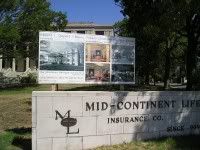 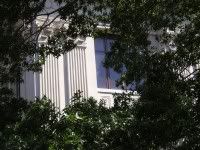
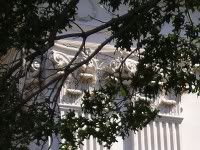 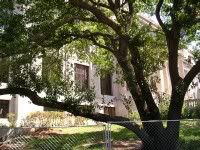
Improvements On The North Side From the Association's Website
Creating An Undereground "Mechanical" Facility
 
A Couple I Took Yesterday of the North Side
 
Website Drawings Showing What Is To Be (larger pics not available)
 
 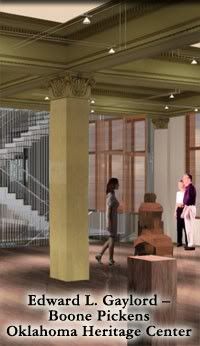
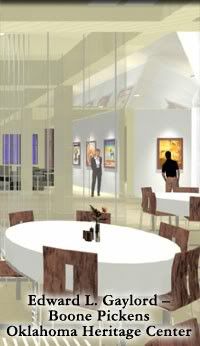 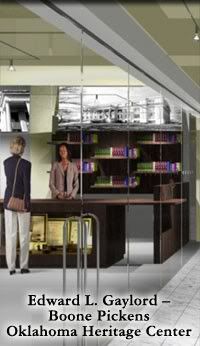
If the finshed place lives up to its billing ...
Northern Light Productions, one of the country’s premier film and video production companies, is telling the story of Oklahoma’s people with cutting-edge hologram technology. The Boston-based company is a leader in developing innovative, immersive, and interactive visitor experiences for museums across the country. Some of Northern Light’s creations can be seen at the Smithsonian Institution, the International Spy Museum, and the National Archives. Founded in 1982 by independent documentary filmmaker Bestor Cram, his team of professionals is committed to the moving image as an art form. Holograms will literally tell the stories of Oklahomans, thrilling museum-goers. “Here in Oklahoma City, we are planning on introducing a unique blend of traditional and cutting edge motion picture exhibition techniques to be the core of a very spirited and meaningful presentation”, Cram said. “At the Oklahoma Heritage Association’s new home, visitors will truly become part of the exhibit. The museum will be constantly changing, never the same, always evolving. And that translates into a remarkable expression of what is taking place in Oklahoma.” ... this will be very cool! Let's go have a peek when it's done, maybe by the end of 2006, but, at least, by sometime during Oklahoma's Centennial in 2007.
... Click here to read the full article and any comments ...
Perle Mesta
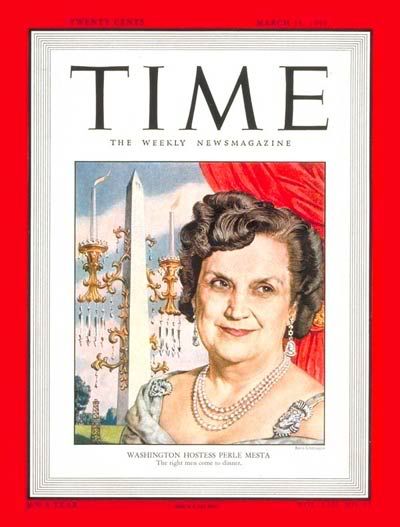 This child of Bill Skirvin was mentioned in the last post on the Skirvin Hilton. Though not an Oklahoman by birth or by much of the time in her life, by reputation, at least, she was an Oklahoma City girl. Born October 12, 1889, in Sturgis, Michigan, she moved to Oklahoma City in 1906, even though her dad, Bill Skirvin, participated in the Oklahoma 1889 Land Run in the same year. He didn't stick around for long since reports indicate that he moved his family Alta Loma, Texas, near Galveston Island. After a devastating 1901 hurricane destroyed Galveston Island, he purchased an acre in the Spindletop Dome area south of Beaumont and, there, he made a killing. According to the 1949 Time Magazine article,
With his profits [from his Alta Loma investments], Billy Skirvin bought an acre in the new Spindletop field near Beaumont, and hit oil. The Skirvins struck it rich. In 1906 Billy moved his family to Oklahoma City, set up the American Oil & Refining Co. and sold shares in its holdings. With the money, he built the 14-story Skirvin Hotel, still one of Oklahoma City's best. So, when Perle arrived in Oklahoma City in 1906, she would have been about 17 years old. According to an Oklahoman article, she attended "music school in the east" after which she married in 1917. After that, she apparently only returned to Oklahoma City to visit, except for a brief residence after her husband died in 1929 and except that, due to her broken hip, she returned to Oklahoma City in 1973 to be near her brother, O.W. Skirvin. She died in Oklahoma City on March 16, 1975.
Bill Skirvin built a house at 700 NW 16th in 1909 or 1910 (reports vary on the construction date). He took title to the lot on which the home was built from Anton Classen's company (The Classen Company) on January 9, 1909, and Skirvin's company sold the property to another on August 11, 1911, according to official deed records. So, it's kind of hard to say that the house at which the family lived for only two or so years could be considered Perle Mesta's "childhood home", even though it is widely regarded as such. An August 19, 1989, Oklahoman article's headline reads, "Perle Mesta's Childhood Home Purchased."
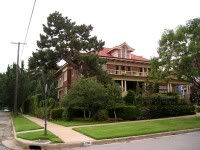 It remains known as that until this day. Here's what it looks like today. Click the pic for a larger image. It remains known as that until this day. Here's what it looks like today. Click the pic for a larger image.
Much of the neighborhood west of Walker to Classen, south of NW 23rd to around NW 16th, bears her name today and is the Mesta Park Historic Preservation District. I live in this neighborhood and her former home is about 4 blocks from my house. My home, also built in 1910, is not nearly so grand as the Skirvin/Mesta home, though! Here's the neighborhood association website: http://www.mestaparkna.com/.
A May 28, 2006, article in the Sunday Oklahoman gives a short and interesting version of her life story:
Hostess with mostes' left mark on state, D.C.
By Brandy McDonnell
The Oklahoman
Editor's Note:
Leading up to Oklahoma's Centennial, The Oklahoman will profile Oklahomans who significantly contributed to the state's success.
'Call Me Madam' film screening
The Mesta Park Neighborhood Association will sponsor a screening of the film "Call Me Madam" at 6 p.m. July 29 in Kerr-McGee Auditorium at the Meinders School of Business at Oklahoma City University, 2501 N Blackwelder.
The film, a 1954 Oscar winner, is the screen adaptation of Irving Berlin's hit musical of the same name. Berlin based the musical on the life of Oklahoma resident Perle Mesta, for whom the Mesta Park neighborhood is named.
* * *
Attendees are invited to wear '50s finery and compete for costume prizes.*** Famed for her lavish Washington, D.C., parties, Oklahoman Perle Mesta became the original "hostess with the mostes'" and earned a place in Broadway and film history.
But her business acumen, political savvy and support of women's rights also set her apart.
"I think she is a little overlooked (in Oklahoma history)," said Ken Lindquist, board member of the Mesta Park Neighborhood Association. "She was a woman ahead of her time in some ways."
Born Oct. 12, 1889, in Sturgis, Mich., Mesta moved with her parents to Oklahoma City in 1906. Her childhood home in the Mesta Park neighborhood, which is named for her, still stands at 700 NW 16. She gave her first party in the family home, according to The Oklahoman archives.
She was the daughter of affluent oilman William Skirvin, who built the Skirvin Hotel. She learned the art of hospitality playing host to guests at the hotel, which is being renovated and scheduled to reopen next year.
After attending music school in the East, she married in 1917 over her father's objections. Her husband was George Mesta, a prosperous engineer who founded Mesta Machine Co. in Pittsburgh.
She became involved in her first social work in her husband's mills, helping to start nursery care centers for children of employees.
When her husband became a wartime consultant for President Woodrow Wilson, the couple moved to Washington, D.C. There, she was active in children's welfare projects and received her first introduction into Beltway politics and society.
The couple traveled across Europe after World War I, according to Encyclopaedia Britannica. The travels helped Perle Mesta gain a far-reaching knowledge of world business and politics.
After her husband died of a heart attack in 1925, she took an active role in managing his vast steel and manufacturing business. She didn't resign as director of the company until 1949, when President Harry Truman named her ambassador to Luxembourg. She kept stock in the firm until her death, according to The Oklahoman archives.
She also engaged in business ventures ranging from a dairy business to a cattle ranch with her brother and sister.
She moved back to Oklahoma City for a time after she was widowed. In 1929, she settled in Newport, R.I., and became a well-known hostess there, according to Encyclopaedia Britannica.
In the 1930s, she became involved in the National Woman's Party. She lobbied for the Equal Rights Amendment, first as a Republican and then, after changing party affiliation in 1940, as a Democrat.
She moved back to Washington, D.C., about 1940 and quickly became one of the capital's premier party hostesses. The guest list for her extravagant soirees included senators and congressmen of both parties, world leaders, Supreme Court justices, movie stars, foreign ambassadors, military leaders and White House personnel.
A Christian Scientist, Mesta didn't drink alcohol, but claimed her parties gave her the same elation liquor gave other people.
She was an early supporter of Truman, serving on the Democrats' finance committee during his 1948 campaign and then acting as co-chairman of his inaugural ball. In 1949, Truman named her minister to Luxembourg. She was the first to hold the post -- diplomatic relations with the country were previously handled by the U.S. ambassador to Belgium -- and the third woman appointed to a foreign diplomatic post.
She served until 1953, becoming the first woman to receive Luxembourg's highest honor, the Grand Cross of the Crown of Oak.
As minister, she became famed again for her hostess skills. She threw "GI parties" for servicemen and women stationed in Europe.
She also became well known for her title. When asked how she wanted to be addressed, she replied, "Call me Madam Minister." The line was shortened to "Call Me Madam," which became the name of Irving Berlin's musical inspired by her life. The musical featured the song "The Hostess with the Mostes'," and Mesta was amused when the nickname stuck to her.
Starring Ethel Merman, the show was a 1950-52 Broadway hit and was adapted into a 1954 Academy Award-winning film. The Mesta Park Neighborhood Association will sponsor a fund-raising screening of the film at 6 p.m. July 29 at Oklahoma City University.
After leaving Luxembourg, Mesta spent much of the next decade traveling the world. She met with the heads of 19 different governments, even touring Soviet Russia. She narrowly escaped death in 1955 after getting caught up in a riot between Communist and anti-Communist factions in Saigon, Vietnam.
In 1960, she published her biography, "Perle: My Story." She continued to give lavish parties into the early 1970s.
A broken hip in 1973 prompted her to move back to Oklahoma City to be close to her brother, O.W. Skirvin. She died of hemolytic anemia March 16, 1975, at age 85. She is buried in Pittsburgh.
Contributing: News researcher Mary Phillips. The much longer Time Magazine 1949 cover story is a bit more expressive. Here are a few snippets:
Widow From Oklahoma
Posted Monday, Mar. 14, 1949
Last week, in a richly furnished room overlooking the lights of Washington, the Vice President of the United States danced a little solo to the strains of an accordion and a guitar. Secretary of the Treasury John Snyder and Postmaster General Jesse Donaldson beat time, grinning appreciatively. With the Italian ambassador and the others, Senator Tom Connally and Colonel Louis Johnson, the new Defense Secretary-to-be, caroled My Old Kentucky Home and The Eyes of Texas Are Upon You. Mrs. Perle Mesta, all gotten up in a brown net Dior dress, was entertaining at "Uplands."
Perle Mesta is the capital's No. 1 hostess, a position she had inherited, almost by default, from a long line of free-spending, haughty, and sometimes charming dowagers. Hostess Mesta had discovered a useful and economical secret: her kind of guests like to entertain each other. At Perle Mesta's parties, Harry Truman has played the piano, General Ike Eisenhower has sung Drink to Me Only with Thine Eyes (in a shaky baritone), Pat Hurley, without too much encouragement, has given his Comanche war whoop, and Mrs. Cornelius Vanderbilt has whistled in a duet.
On such jolly occasions, the food is always bountiful, the liquor excellent and plentiful. A teetotaler herself, Mrs. Mesta sips Coca-Cola and warily watches the spirits rise around her. She likes everybody to be gay, but not to get out of hand. It is a kind of entertaining peculiarly suited to the plain Government of plain Harry S. Truman. So is Hostess Perle Skirvin Mesta.
The Cribbage Board. A hearty, goodfellow type of woman, Perle Mesta is an Oklahoma widow, whose wealth came from a marriage of Oklahoma oil and Pittsburgh machine tools. Not even her warmest admirers, who liked her liveliness, would credit her with overwhelming charm or notable wit. But ambassadors, Senators and Cabinet officers come at her beck. In a city where a hostess' success can be scored like points in a cribbage game by counting up the rank of her guests, Perle Mesta outscores them all. Unlike her predecessors, Perle Mesta won her position not by prestige and not alone by wealth. She won by 303 electoral votes —those that elected Harry Truman.
Professional society is based on entertaining people who are not necessarily your friends. Washington visitors are astonished at the ferocity with which it is practiced in the capital. Years of rigorous competition have produced a prototype of the hardy, or winter-blooming Washington hostess. She is a widow, past 60, of ample means and ample bosom. She must have enough forwardness to fight for her prey, enough toughness to withstand the fangs of her rivals.
* * *
Center Ring. The main ring in Washington's three-ring circus is the official circle. Here are the big governmental names which the successful hostess, of whatever circle, must catch. Most of them are ready to be caught: they hold offices of high prestige and medium salaries, which limit their own powers of entertaining. In, this ring, Perle Mesta is supreme.
Perle Mesta's parties are neither so fancy nor so noisy as Mrs. Evalyn McLean's, so exclusive as Mrs. Truxtun Beale's, so smart as Mme. Bonnet's at the French embassy. Her menus are adequate but not sumptuous. At the Alben Barkley dinner last week, the 24 guests had turtle soup, filet of beef, peas, browned potatoes, aspic salad, and a rum-and-ice-cream dessert.
No Senator need worry at a Mesta party if he cannot quote Oscar Wilde, if he thinks Picasso is a ham & eggs painter, or is unable to pronounce the name of French Premier Queuille. In the new, hearty Mesta milieu, the lorgnette has abdicated to the guitar. Said a friend: "You go to a great many beautiful formal houses here where people barely speak above a whisper. You go to Perle's, and you know it's going to be fun."
* * *
Little Girl. When she is asked about her past, Perle conjures up a picture of an Oklahoma childhood liberally sprinkled with scenes of little Perle in colored hair ribbons matching the sash around her waist. The little girl lived in a big, red brick mansion with stables out back, where each child had its own Shetland pony. Perle likes to say that she organized her first party on her twelfth birthday.
* * *
No Shoes. Billy Skirvin did not go in for society stuff. He loved to sit in the lobby of his hotel in his stocking feet, talking. In later years, he drank, and about 9 o'clock every evening, a thin, wiry little woman would come down to the lobby, pick up his shoes and lead him off upstairs. She was Mabel Luty, and she was his confidential secretary for 31 years.
But Billy did his best to make Pearl (he never could remember to spell it Perle) happy. He put $36,000 into sending her East, gave her a fancy car, and kept her there in good husband-catching style. In 1916, Perle met George Mesta. A year later she married him. George Mesta was 54, a tall, blond man of Italian descent who was president of the Mesta Tool Co. in Pittsburgh, and a World War I $1-a-year man in Washington. For Perle, he was the first big step. After the war, he took her abroad 22 times, started building her a $600,000 limestone house in Pittsburgh where she could entertain. He contributed $100,000 to Coolidge's campaign, and Perle was rewarded with three overnight visits to the White House. Then in 1925, Mesta, to whom his wife referred affectionately as "the wop," died. Perle got $845,000.
* * *
Getting Ahead. Perle never lived in the $600,000 house, which was finished just before Mesta's death. She found Pittsburgh society "too stuffy." She bought a place in Boston, and sold it after two weeks, bought a cattle ranch in Arizona, and resold it because it was "too lonely out there." She also took a place in Newport, began entertaining cautiously and discreetly, got inside the door at aloof Bailey's Beach, eventually established herself firmly among the matriarchs of Millionaire's Row. She struck up a friendship with Hoover's courtly Vice President Charles Curtis, who spent a week at her Newport mansion. He got her presented at the Court of St. James's in 1931.
Once Perle Mesta had to drop her social campaigning and hurry back to Oklahoma City. There brother O. W. Skirvin was keeping an eye on old father Billy. He peeked into his father's safe, found the old man had made out stock transfers of his American Oil shares to his three children.
Billy learned of his son's doings, in a fury tore up the certificates.
Perle sued her father for misappropriation of the hotel's and oil company's assets. Some suspected that Perle was afraid faithful Secretary Mabel Luty would get her inheritance. Receivers were appointed and the case was bitterly argued for six years. In court, old Billy wept. The judge bellowed at them: "You Skirvins ought to be ashamed of yourselves."
On appeal, the court turned the properties back to Billy. That same day, he was injured in an automobile accident, died two weeks later. Perle got about $400,000. The article contains much much more interesting stuff and it is all on-line. I'll close with a few factoids and pics:
Factoids: She was a mystery guest on CBS's What's My Line on August 12, 1956, and a CBS's Playouse 90 did a play about her on March 21, 1957, Shirley Booth playing her adult character and Evelyn Rudie playing her when younger. Paul Lesch, a Luxembourg resident, recently wrote a book, Playing her Part: Perle Mesta in Luxembourg. See http://www.amcham.lu/publications/perlemesta.php.
Pics:
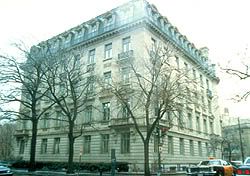 McCormick Apartments, where she lived and partied-down in Washington (some of the time). It now houses the National Trust For Historic Preservation. The description there is impressive! McCormick Apartments, where she lived and partied-down in Washington (some of the time). It now houses the National Trust For Historic Preservation. The description there is impressive!
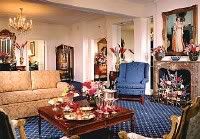 Perle Mesta Suite at D.C.'s Wardman Park Marriott near Dupont Circle. She has a restaurant there, too! Click the pic ... it's cool! Perle Mesta Suite at D.C.'s Wardman Park Marriott near Dupont Circle. She has a restaurant there, too! Click the pic ... it's cool!
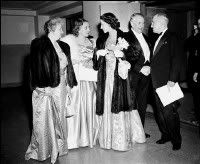 A 1949 Party With The President: Left to right: Truman's wife Bess, daughter Margaret, Perle, Vice President Barkley, and President Truman. See this link. Click the pic for a larger image. A 1949 Party With The President: Left to right: Truman's wife Bess, daughter Margaret, Perle, Vice President Barkley, and President Truman. See this link. Click the pic for a larger image.
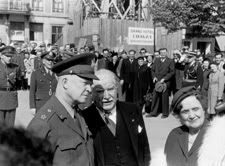 From a film, Call Her Madam, at a Luxemborg website. From a film, Call Her Madam, at a Luxemborg website.
 This 1952 pic is from Scott Foster's Aloha Oklahoma!, showing Zsa Zsa Gabor, Perle, and some guy with hands. Click the pic for a larger image. This 1952 pic is from Scott Foster's Aloha Oklahoma!, showing Zsa Zsa Gabor, Perle, and some guy with hands. Click the pic for a larger image.
Is Perle an Oklahoma City "Hero"? No, probably not. She really didn't contribute to this city in any way that I know of, unlike her father, and she hardly lived here. Still, she's certainly a fascinating part of our history in which we can participate, vicariously!
... Click here to read the full article and any comments ...
Also, see Skirvin Hilton Preview, Skirvin Hilton: The Day Before, and Grand Reopening. 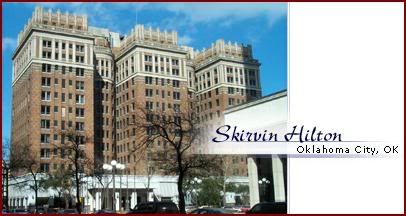 ORIGINS ORIGINSWilliam Balser "Bill" Skirvin, a Michigan native, made the Run of 1889 but then moved to Texas where he made a fortune in land development and oil. In 1906 he and his family, including his oldest daughter Perle (who later would become Perle Mesta, the Washington and international "Hostess With the Mostest" and about whom a Broadway musical and movie, Call Me Madam, were made ... but that's another story) ... moved to Oklahoma City. In 1910, Skirvin decided to build a fine hotel on property he owned at 1st (Park Avenue) and Broadway, and he joined forces with Solomon A. Layton who designed the state capitol building. The original plans called for 6 stories, but, according to Skirvin's daughter, Pearl (ed note: sic - should be Perle) Mesta, the archetect persuaded Mr. Skirvin to expand it to 10 stores. The 225 rooms and suites Skirvin Hotel opened on September 26, 1911. See Bob Blackburn's excellent article for much more detail.
Postcard showing the 1911 exterior
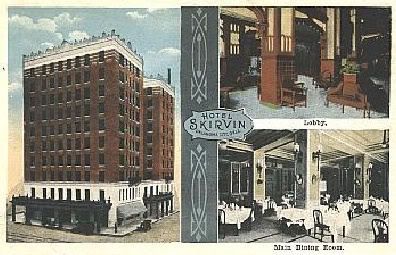
Postcard showing the lobby

In Bob Blackburn's article, we read,
During the next 10 years the guest register of the Skirvin Hotel reflected the frontier character of the young, bustling state. Guests included cigar-chomping politicians, free-wheeling ranchers, blanketed Indians from the state's 70 tribes, oil-rich millionaires, mud-covered drillers, and even notorious bank robbers such as the famed Al Jennings, the ex-convict who launched his bid for governor from the lobby. Skirvin, always impeccably dressed in his well-pressed suit, welcomed all with open arms. EXPANSION AND DECLINE
A 1926 expansion added new wing of 12 stories to the existing two wings with 10 stories. But, the economy was going great and a final expansion was completed in April 1930 raised all wings to 14 floors and with a capacity of 525 rooms and suites, as well as numerous other changes and and added amenities.
Construction in the 1920s

The Final Product in 1930

Coffee Shop in 1930
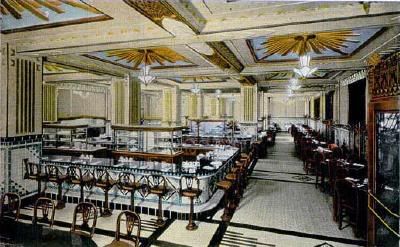
Venetian Room in 1930
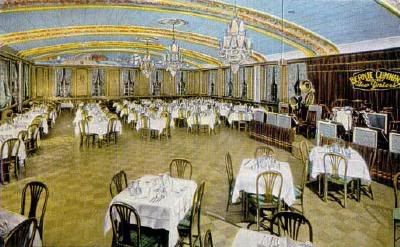
Bill Skirvin continued to own the hotel until he died in 1944 from injuries sustained in an auto accident. In 1945, his children sold the Skirvin (and its across the street cousin, the Skirvin Tower) to Dan W. James, owner of the Black Hotel and, over a 10 year plan, James invested considerable resources in improving the services and quality which had apparently declined during World War II. Harry Truman and Dwight Eisenhower were guests in 1948. James added a pool in 1959.
Beginning with James' 1963 sale to Chicago investors, the property changed hands a few times during the difficult downtown days of Oklahoma City ... during the Urban Renewal phase, suburban malls, oil bust, etc. Although Bob Blackburn's article is much more thorough about this topic and ends on an optimistic note at the time his article was written (1982), the apparent rejuvenation and optimism then present did not persist. The Skirvin's doors were closed in 1989 and have not since reopened.
REBIRTH
The Skirvin was acquired by the City of Oklahoma City in 2002. From the City of Oklahoma City's website,
"Saving the Skirvin is a high priority for our citizens. After more than 10 years, it’s clear the City’s intervention is necessary to make that happen," [Jim] Couch said.
In 2004, the Urban Renewal Authority and City Council chose the Skirvin Partners group to buy and restore the hotel.
The City has developed a financing package that will not only allow developers to renovate, restore and reopen the Skirvin, but could actually provide the City with a direct return on its investment of $1 million to $5.6 million. That's in addition to $15 million in various taxes the hotel could generate over 15 years.
"This is revolutionary. This is unheard of in the industry." That's how consultant John Keeling described the groundbreaking proposal.
"This is a deal other cities will come and ask you about, wanting to know how you did it," Keeling told City Council at its May 11, 2004 meeting.
The grand dame of Downtown Oklahoma City will reopen as an elegant hotel with at least 165 fulltime employees. The Skirvin Partners joined forces with Marcus Hotels and Resorts, a Wisconsin company, to restore and eventually manage The Skirvin Hilton. According to the Marcus Hotels & Resorts website, the Skirvin Hilton will open in March 2007, just 6-7 months from the time this article is written. From that website and from the Skirvin Hilton website come the following drawings (click on an image for a larger pic):
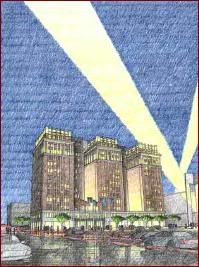 
 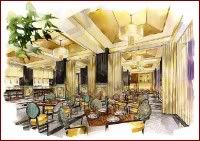
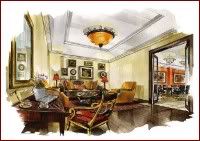 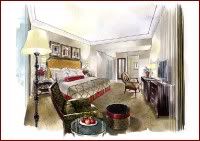

The guest rooms and suites will apparently be larger ... the 1930 configuration contained 525 rooms and suites but, according to the Marcus Hotels' website, "The newly renovated hotel will open in March 2007, unveiling 225 guestrooms, including 20 suites and one Presidential suite." It will also include 22,000 square feet of meeting and pre-function space, a "destination lounge and signature restaurant", flat panel high-definition televisions, wired and wireless high speed Internet access, a fitness center & swimming pool, a "Hilton Honors lounge", and a business center. The City's website puts the guest room/suite count at 235.
AUGUST 19 PROGRESS
On Saturday, 8/19/2006, I took a few pics to see how it was coming. Here are a few ... notice the close-ups of exterior moulding, sometimes deteriorated, but racks of new replacement moulding being used when needed appear on the sidewalk. Click a pic for a larger image.
South Side Moulding Previously Hidden by a Facade
 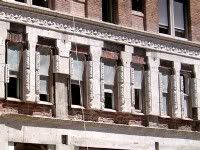
Replacement Moulding
 
Windows & Moulding
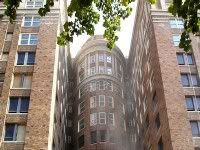 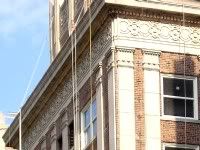
North Side
 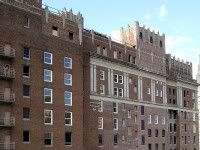
North Side Courtyard and Ballroom Entry
 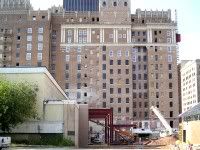
If that's not enough, another 10 pics are at my Photobucket pics.
What a great day it will be, hopefully in March 2007, to remember Bill Skirvin's contribution to this city, and to congratulate our city leaders, and ourselves, for the fine thing we will have done that day! "We?", you say? Yep ... all residents of Oklahoma City will have had a large or a small hand in making this happen vis a vis our City's government. We can rightly call the Skirvin, "our" hotel!
Go To Top
... Click here to read the full article and any comments ...
|























 McCormick Apartments, where she lived and partied-down in Washington (some of the time). It now houses the
McCormick Apartments, where she lived and partied-down in Washington (some of the time). It now houses the 

 From a film, Call Her Madam, at a
From a film, Call Her Madam, at a 




































